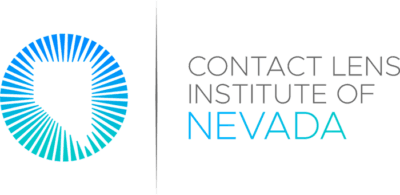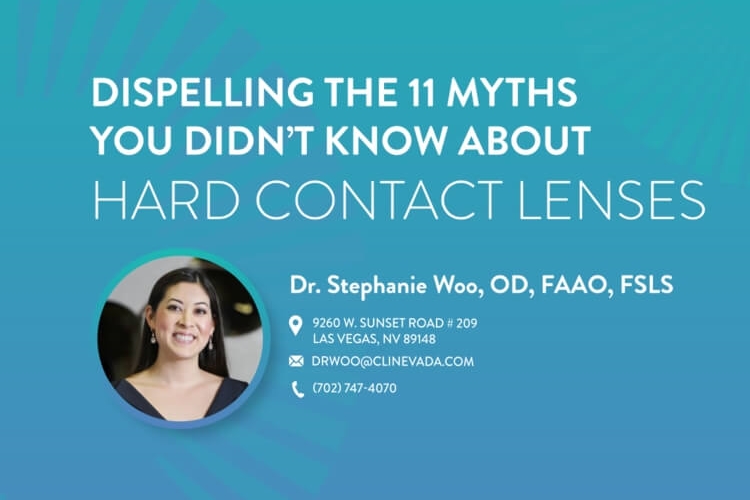LENS TYPES
SPECIALTY CONTACT LENSES
Specialty contact lenses can help treat and manage a wide variety of eye conditions and vision problems. We work closely with contact lens manufacturers to further the science and add our applied learning to taking on some of the most challenge problems that specialty contact lenses treat.
GAS PERMEABLE LENSES
Our office is dedicated to all gas permeable lens options including:
- Spherical gas permeable
- Bitoric gas permeable
- Gas permeable multifocal
- Intralimbal gas permeable
- Keratoconus designs
- Corneal transplant designs
- Irregular astigmatism designs
- Pediatric designs
EYEPRINT PROSTHETIC
Our office is the only office in the state of Nevada certified to fit and manage the EyePrintProsthetic. The EyePrint first involves obtaining an impression of the entire ocular surface, similar to taking a dental mold. The process is safe, painless, and only takes 80 seconds. Next, the impression is sent to the laboratory where a 3-D scanner is used to evaluate over 3 million points. Then, a prosthetic lens is fabricated unique to the patient’s eye. No two EyePrint devices are the same! This revolutionary technology allows for complete customization of the ocular surface. Some patients choose this design because they want the perfect fit when it comes to their contact lens needs; with other patients, the EyePrint is the only option for their ocular condition. EyePrint is hope.
sMap
The Contact Lens Institute of Nevada is the only office in Nevada offering sMap technology. The sMap instrument offers the highest level of technological precision for mapping the shape of the eye. The sMap corneal-scleral topographer captures data points on the entire ocular surface, creating highly detailed maps with ability to design totally customizable scleral lenses. The system allows for in depth consultation with the manufacturer of the lenses, resulting in an excellent product. The sMap can be used to fabricate the Latitude lens, which is a completely customized scleral lens.
HYBRID LENSES
Hybrid contact lenses combine the benefits of vision within a gas permeable lens with the comfort of a soft lens. The center of the lens is created by integrating information about the shape of the eye with the prescription, yielding great vision. The skirt of the lens is made of a high oxygen soft contact lens material, allowing for more comfort compared to a traditional gas permeable lens. Hybrid lenses are great for patients with astigmatism, as well as presbyopia. There are also hybrid lens designs for keratoconus patients, as well as irregular corneas.
CUSTOM SOFT LENSES
When standard soft lenses do not meet your comfort or vision expectations, custom soft lenses are an obvious next choice. Standard contact lenses are only available with certain lens parameters. If your prescription falls outside of these parameters, custom lenses may be your only option. Another great feature about custom lenses is they can be manufactured with different shapes, sizes, and prescriptions. Since the lens is customizable to your exact prescription, the success rate is very high. Custom soft lenses may also be an option for patients suffering from keratoconus or corneal transplants. When gas permeable or scleral options do not work, custom soft lenses could be the answer.
PROSTHETIC CONTACT LENSES
Patients suffering from ocular trauma or disfigured eyes may be good candidates for prosthetic contact lenses. Special contact lenses are color matched to the opposite eye, resulting in a more normal appearing eye structure. They can also be used to control the amount of light entering the eye, which is helpful for patients with aniridia or ocular albinism. Our clinic offers tinted contact lenses, computer-generated colored lenses, and hand painted contact lenses.
ORTHOKERATOLOGY
Orthokeratology or corneal reshaping involves a special type of gas permeable lens used to reshape the front surface of the eye. A lens is designed based on eye shape and prescription, which is then fabricated and sent to our clinic. The patient wears the lens at night, which causes a shift in the front surface of the corneal cells. This is similar to wearing a dental retainer at night to keep teeth straight. In the morning, the lens is removed, and patients enjoy clear vision all day and night. Most patients must wear these contact lenses each night to achieve this effect, but some patients maybe only have to wear them a few times per week. A benefit to orthokeratology is that it can help slow down the progression of myopia. Orthokeratology is safe and completely reversible.
PEDIATRIC CONTACT LENSES
We offer the gold standard options when it comes to pediatric designs. Soft contact lenses and gas permeable options for aphakia are both available at the Contact Lens Institute. Custom soft lenses are available for children with extremely high prescriptions or amblyopia. Soft multifocal lenses and orthokeratology lenses are offered for myopia management.
SCLERAL CONTACT LENSES
Scleral lenses are special contact lenses made from a high oxygen permeable material. Scleral lenses are very comfortable for the patient, due to decreased eyelid interaction and lens movement. Another benefit is that they do not dislodge or pop out of the eye, which is a common problem with corneal gas permeable lenses. There is also decreased foreign body entrapment, another common issue with hard lenses or gas permeable lenses in which a piece of dust or dirt gets behind the lens and causing intense pain. The fluid layer created by the scleral lens creates a comfortable ocular environment throughout lens wear. Scleral lenses are fit by a practitioner trained in this technology, and our office is proud to offer the latest technology in scleral lens options.
TECHNOLOGIES
OVITZ HIGHER ORDER ABBERATION TECHNOLOGY
A state-of-the-art patented technology system to enable patients to see unlike ever before. The OVITZ™ xwave system captures over 28 complex visual aberrations and provides individualized vision correction not possible with other readily available methods today. By eliminating higher-order aberrations of the entire visual system, patients can see optimally with vivid, ultra-sharp vision. Ideal candidates include any patient with irregular corneas and also normal patients seeking vision beyond 20/20.
EYEPRINT PROSTHETIC
Our office is the only office in the state of Nevada certified to fit and manage the EyePrintProsthetic. The EyePrint first involves obtaining an impression of the entire ocular surface, similar to taking a dental mold. The process is safe, painless, and only takes 80 seconds. Next, the impression is sent to the laboratory where a 3-D scanner is used to evaluate over 3 million points. Then, a prosthetic lens is fabricated unique to the patient’s eye. No two EyePrint devices are the same! This revolutionary technology allows for complete customization of the ocular surface. Some patients choose this design because they want the perfect fit when it comes to their contact lens needs; with other patients, the EyePrint is the only option for their ocular condition. EyePrint is hope.

